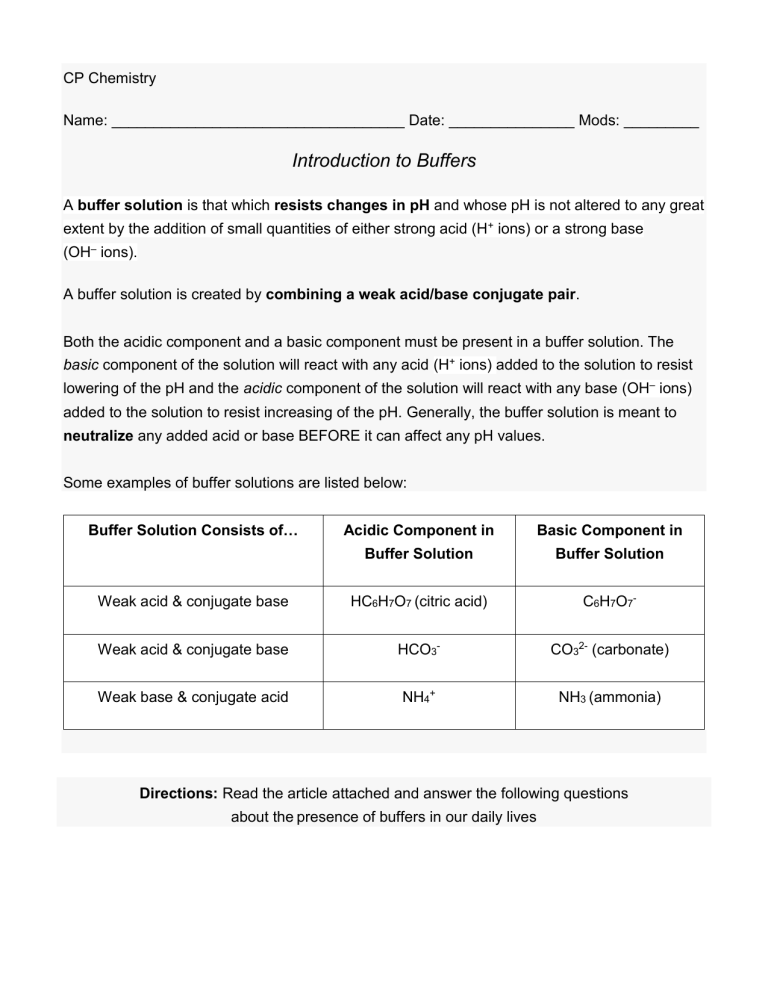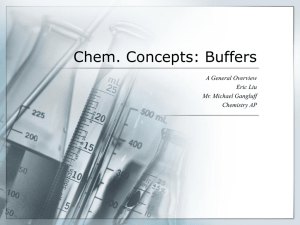Buffers in our Daily Life by Alex Reis

CP Chemistry
Name: ___________________________________ Date: _______________ Mods: _________
Introduction to Buffers
A buffer solution is that which resists changes in pH and whose pH is not altered to any great extent by the addition of small quantities of either strong acid (H + ions) or a strong base
(OH
–
ions).
A buffer solution is created by combining a weak acid/base conjugate pair .
Both the acidic component and a basic component must be present in a buffer solution. The basic component of the solution will react with any acid (H + ions) added to the solution to resist lowering of the pH and the acidic component of the solution will react with any base (OH
–
ions) added to the solution to resist increasing of the pH. Generally, the buffer solution is meant to neutralize any added acid or base BEFORE it can affect any pH values.
Some examples of buffer solutions are listed below:
B uffer Solution Consists of…
Acidic Component in
Buffer Solution
Weak acid & conjugate base
Weak acid & conjugate base
Weak base & conjugate acid
HC
6
H
7
O
7
(citric acid)
HCO
3
-
NH
4
+
Basic Component in
Buffer Solution
C
6
H
7
O
7
-
CO
3
2 (carbonate)
NH
3
(ammonia)
Directions: Read the article attached and answer the following questions about the presence of buffers in our daily lives
Buffers in our Daily Life
by Alex Reis
Buffers and industrial applications
Multiple industrial processes rely on buffers, including pharmaceuticals, food and textiles, just to name a few. Let’s have a look at some examples:
Pharmaceutical industries
Many different therapeutic drugs are synthesized under strict pH conditions to ensure the stability and clinical effectiveness of these treatments. This is usually achieved with buffer solutions. Since the buffer’s job is to maintain a consistent pH regardless of changes made to the solution, the buffer solution makes it possible for drugs to perform at their peak at an appropriate pH value. In addition, buffers can be used to:
Increase the drug’s shelf-life
Maintain the drug in a specific un-ionized or ionized form, depending on the type of solution used. For example, ionized forms tend to be more soluble in water, while unionized forms are more soluble in lipids (fats in the body). This is significant because drugs dissolved in lipids generally last longer in your body so they provide longer-term symptom relief compared with water soluble drugs which are fast acting but quickly pass through the body.
Maintain the drug in a near-neutral pH, this way avoiding any irritation to the body tissues
Fermentation
Fermentation reactions – such as in alcoholic beverages or yogurt – are highly affected by varying pH. This means it’s essential to use buffer solutions to avoid harsh changes and allow fermentation to progress to obtain maximum yield.
For example, in bread, the pH of the dough will naturally drop with the production of CO
2
(a product of the bread-making process) and some other organic acids. Within the bread dough, natural buffers as well as milk, flour, and other chemical products such as calcium bicarbonate
(Ca(HCO
3
)
2
) can be used to limit pH variations during fermentation and maintain a consistent pH.
Specialized buffers are also used extensively in the food industry as food additives, in particular to ensure the appearance and flavor of certain food items, as well as delaying any microbiological “invasion”. This buffer additives can prolong the shelf-life of these foods.
Other industries
Manufacture of glue: properties of some ingredients used in the manufacture of glue, such as gelatin, change significantly even within minute alterations in pH. Buffers are used to avoid these changes.
Electroplating: Plating of some alloys can only be successfully completed if pH is kept under narrow limits. This is a process which is necessary to mint U.S. pennies; a thin layer of copper is plated on top of the (which makes up the majority of a penny).
Printing: Buffers are used during printing to ensure the ink maintains its normal properties. Incorrect pH may affect how the ink penetrates and dries on the paper, altering the final result.
Buffers in nature
Buffers in water
Like any other organism, aquatic life forms need a stable pH in their environment. However, there are many factors which may significantly alter this parameter leading to unsuitable conditions for fish and sea plants to thrive in water. One of the major problems is pollution in the form of acid rain. This acidity is derived from sulfur dioxide (SO
2
) emissions which are converted to sulfuric acid (H
2
SO
4
) in the clouds and dissolved in rain water.
Acid Rain Formation: SO
2
+O
3
(from the sun) H
2
SO
4
H + + SO
4
2-
When a body of water is affected by acid rain, its natural buffering systems get into operation.
This includes, for example, the reaction between carbonate (CO
3
2 and HCO
3
) and hydrogen
(H + ) to neutralize its effects.
Natural Buffer System in Water: CO
3
2 + H + HCO
3
+ H + H
2
CO
3
Without this natural buffer in lakes and oceans, the pH would drop critically low causing irreversible damage to aquatic life, particularly affecting gills and fins in fish.
Buffers in soil
The pH in soil is also critical, as plants grow better under specific pH conditions. Also caused by acid rain, acidification of the soil is becoming a serious problem, as natural buffer systems may not be able to cope with such drastic changes. This way, not only vital nutrients are dissolved and washed away, but also the microorganisms responsible for nitrogen fixation and breakdown of organic matter are affected, eventually disturbing the entire ecosystem.
Reading Assessment Questions: Be sure to use specific evidence from the article to answer the following questions:
1) State two ways in which buffers play a crucial role in the pharmaceutical industry.
2) How do buffers prevent the spoilage of foods?
3) The northeastern region of the USA sees the highest levels of acid rain (rain must have a pH below 5.6 to be considered acid rain). What is the natural buffer solution present in water that helps resist changes in pH?
4) Without a the natural buffering system in place in lakes and oceans, what would happen to the pH in bodies of water each time there is acid rainfall? What would happen to aquatic life?
5) The soil in some parts of America is becoming too acidic to support plant growth. While there are natural buffering systems in place in the soil, these buffers seem to be running out; they are no longer able to neutralize added acid or base and thus cannot resist changes in the pH of the soil each time it encounters acid rain. The term buffering capacity is related to this phenomenon. Try to define buffering capacity based on the context above.
6) Think About It: Human blood must maintain a very specific pH of between 7.35 and 7.45 in order for blood cells to perform their required functions. The same buffer that is found in natural watering systems is present in our blood. Explain why a buffer is crucial on out blood.






